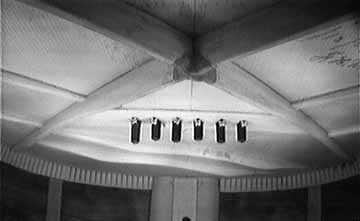Page 1 of 2
Scalloped Braces?
© Frank Ford, 3/18/98; Photos by FF, 3/17/98
What are scalloped braces? Does that mean they're made with milk and cheese? Does
my guitar have scalloped braces? Should I care? What do they do for the tone? If
I have scalloped braces, how come I can't see 'em? If my braces aren't scalloped
can they get scalloped?
Hard to say when all this started. Must have been in the late '50s when players began
to realize that older Martin guitars sounded better than new ones. Looking inside
the guitar, the only differences they could see were the shaping of the top braces.
You have to look with a mirror, because the significant braces are way back inside
from just ahead of the bridge to the end of the guitar. It's never possible to see
scalloped braces by just looking inside the soundhole.
I'm not here to recommend one system or another. I just want to illustrate the
concept of "scalloped" braces because it's a term we hear in conversation
among players and guitar makers.
I believe that players should judge guitars by the way they sound, not by the terminology
used in their construction or advertising.
I constantly refer to Martin instruments because Martin devised the whole system
and because Martin guitars are the only ones that are comparable through so many
decades of production.
Let's look through the INSIGHT video spycam:
The older Martins had top braces that were scooped out with little peaks near the
ends. Here's an interior view of a 1907 Martin 0-18:

Remember that ALL of the older Martins had braces contoured in this general manner,
and Martin never called them "scalloped" or anything else for that matter.
They were just top braces.
For a look at Martin's current bracing systems, please check out Martin Top Braces, in the History section.
The newer ones had straight braces that tapered a bit at the ends. This is a view
inside a 1973 Martin D-28. This guitar also has a large rosewood bridge plate, a
feature that began in the late '60s.

There's quite a bit of disagreement over the effects and benefits of one bracing
system over another. We all agree that IF ALL THINGS ARE EQUAL, namely same maker,
size, style, material and age of guitar, that the scalloped brace instrument will
have more bass response. It's predictable, since bass response is generally increased
if the top is made more flexible, and the scalloped braces are more flexible where
they are cut lower.
Martin is the only really old American guitar company that has made essentially the
same models year after year. It's easy for us to examine guitars of different vintages
and compare their sound and construction features. One question that comes up all
the time: Does it have scalloped braces?
Long about the end of World War II, Martin discontinued the practice of contouring
the braces and started leaving them full height through their length. We refer to
those guitars made before the change to straight braces as "prewar Martins"
even though many were made during the war.
It really doesn't matter if they did it because of loss of manpower to the War Effort,
because they wanted to save money or because they were concerned about strength of
the top. Fact is, they did change the bracing late in the year of 1944. All guitars
made from the beginning of 1945 to 1976 have "straight" top braces. Starting
in 1977, Martin has reissued countless old styles and has made both straight and
scalloped brace guitars.
Because older Martin guitars with scalloped braces became so desirable, people started
referring to their braces as "scalloped," to distinguish them from the
newer style braces. Eventually, other makers, including the Asian imports began to
tout "scalloped braces" as one of their features. These instruments may
have been decidedly inferior, but they did have scalloped braces.
Let's look at some guitar tops.
These are tops removed from destroyed guitars or tops that weren't used in building
new ones because of some small defect.
Here's the straight braced Martin top, this time from a 1974 D-18:

The oversize rosewood bridge plate tends to dampen bass response and volume. It was
a feature found on Martin guitars made during the height of the folk revival of the
1960s & "70s.
Here's the classic scalloped brace design of a 1943 D-18:

Notice the scooped out areas of the lower diagonal braces and the lower end of the
big cross braces. All the upper braces, from the intersection of the "X"
to the neck, are identical. Those are the ones you can see through the soundhole.
More
1
2
Back to Index Page